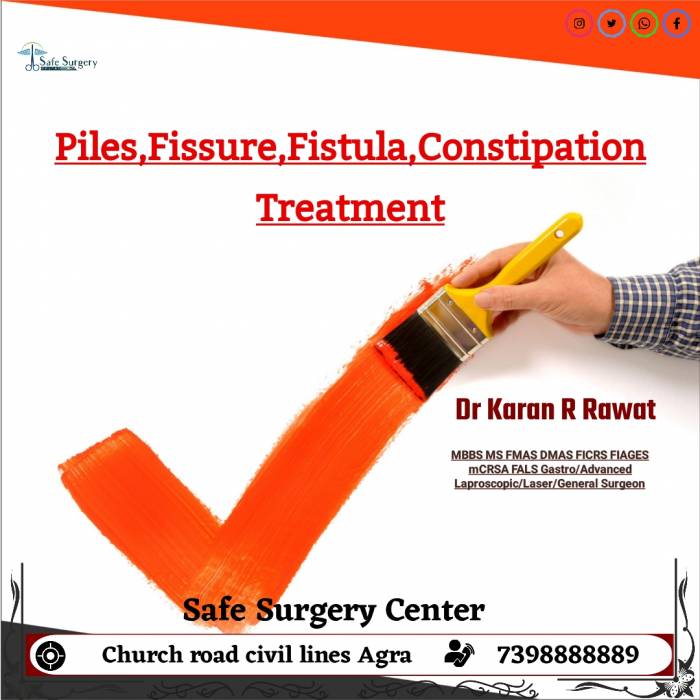
Piles (haemorrhoids)
Hemorrhoids, also called piles, are enlarged or varicose veins of the anus and rectum. They are a common health ailment, particularly in developed countries, affecting nearly 5% of the population. There are two types of hemorrhoids, external and internal, which can occur separately or in combination. A person could have a single hemorrhoid, or have several at the same time.
Symptoms/Complications of Hemorrhoids
External hemorrhoids develop under the skin just outside the opening of the anus. They are usually painful if they develop a clot (thrombose), in which case they appear as very tender, circular, purplish bulges around the anal opening.
Internal hemorrhoids are often present without causing any discomfort or even awareness of their existence. This is because there is rectal lining (mucous membrane) around internal hemorrhoids, rather than nerve-rich skin. You might experience a feeling of fullness in the rectum, as if you need to have a bowel movement. You might not even know you have them unless they clot (thrombose) or bleed, resulting in passing bright red blood during and/or following a bowel movement. However, if a hemorrhoid loses its blood supply (strangulates) it can become very painful. Sometimes an internal hemorrhoid pushes down or stretches until it bulges outside of the anus (prolapse). This could manifest as a pinching sensation in the anal area, or you may notice a painless lump when you wipe after a bowel movement.
The extra bumps and crevasses of hemorrhoids could lead to improper cleaning of the area, resulting in anal itching.
Hemorrhoids have a number of predisposing causes but, in most cases, increased pressure in the abdomen plays a key role. Some of the most common underlying factors for developing hemorrhoids include constipation and straining during bowel movements, repeated lifting of heavy objects, frequent diarrhea, prolonged sitting or standing, obesity, and pregnancy. Excessive abdominal pressure can cause the small veins around the anus and rectum to stretch. As the veins lose their elasticity, they become distended with blood and more likely to thrombose and become more fragile. Pregnant women are particularly prone to hemorrhoids, partially because the enlarging uterus sits directly on the blood vessels that drain veins near the rectum and anus. Hemorrhoids affect up to 38% of women in the third trimester of pregnancy.
Diagnosing Hemorrhoids
Your physician might diagnose hemorrhoids following a physical examination of the anus and rectum. This can include a rectal exam performed with a gloved, lubricated finger, or with a small instrument that will allow your physician to visualize the rectum more closely.
Rectal bleeding could be a symptom of other, potentially more serious, conditions. One source of bleeding could be anal fissures, which are tears in the lining of the anus causing pain when passing a bowel movement. Some types of inflammatory bowel disease can also cause rectal bleeding, as can tumours of the rectum and colon. If you pass blood from the anus, then you should consult with your physician to determine if further testing is required.
Management of Hemorrhoids
It is very important to avoid straining while having a bowel movement, as this puts extra pressure on the anal area. The management of hemorrhoids typically involves a number of moderate dietary and lifestyle changes to ensure soft and formed stools, which help to avoid pressure in the rectal area.
Dietary Modifications
Recommendations for ongoing dietary management include consuming well-balanced meals and snacks and ensuring adequate fibre and fluid intake . Fibre and fluid help soften stool, allowing it to move more quickly and easily through the colon, rectum, and anus, which reduces strain.
Aim for 20-35 g of fibre daily, consumed evenly throughout the day. To help monitor your fibre intake, check the nutrient content on the labels of packaged foods. Make gradual changes while increasing fibre intake, as this approach could help you to avoid the bloating, gas, and general abdominal discomfort that could occur as your body adapts to the dietary modifications.
There are also some commercial fibre supplements available. These include bran, psyllium seed, or ispaghula husk derivatives (e.g., Metamucil®) and inulin (Benefibre®), which is soluble vegetable fibre. For more information on fibre, visit our website or contact our office.
Most hemorrhoid sufferers will find good results with the use of a basic fibre supplement; however, if constipation continues to remain a problem, then products containing the herb senna could offer additional relief. Be sure to check the labels as some of these products contain different substances depending on their format (e.g., powders are different from caplets). Also note that products marked ‘plus’ could contain additional unwanted substances that increase their laxative effect.
Resist the Urge to Scratch
The area around your hemorrhoid might feel itchy. Don’t scratch, as you could damage delicate vein walls.
Clean Carefully
It is extremely important to clean yourself properly and gently following a bowel movement. Use only non-perfumed, non-coloured toilet paper and try dampening it under the faucet before each wipe. Some varieties of toilet paper are softer than are others and some facial tissues contain moisturizing cream, which you may find to be more soothing. Using pre-moistened flushable wipes might also increase cleaning comfort.
Have a Sitz bath
This is a type of therapeutic bath that involves sitting in very warm water with your knees raised. The warm water helps lessen the pain while increasing blood flow to the area. This helps to shrink the swollen veins and promote healing. Adding Epsom salts to the bath water might also help.
Push it Back Inside
If your hemorrhoid protrudes from the anal canal, try gently pushing it back inside. A hemorrhoid left hanging out of the anus is at a greater risk of developing clots or strangulating.
Hemorrhoids During Pregnancy
To help prevent or manage hemorrhoids if you are pregnant, try lying on your left side for about 20 minutes every 4-6 hours, as this decreases pressure on the main vein draining the lower half of the body.
Ointments and Creams
Hemorrhoidal symptoms often subside within a few days, even with no specific treatment. Topical hemorrhoid treatments usually contain one or more active ingredients including a local anesthetic, mild anti-inflammatory compounds, or astringents.
Local anaesthetics temporarily relieve pain, burning, and itching by numbing the nerve endings. Analgesic products relieve pain, itching, and burning by depressing receptors on pain nerves.
Witch hazel is a widely used plant-based astringent; when applied to the rectum with a cotton ball, this product can offer relief. Several other products have stronger ingredients that focus on reducing inflammation and these may require a prescription.
Surgery
If significant hemorrhoidal symptoms persist despite conservative measures, a number of minor surgical options are available and a physician may perform many of these in the office. Treatment for internal hemorrhoids includes application of rubber bands (ligation), injection of a material (sclerosant) that blocks the vein, stapling, cryosurgery, laser, or electro-coagulation techniques. Surgical excision that is more extensive might be required for large, permanently prolapsed hemorrhoids or strangulated hemorrhoids. Thrombosed external hemorrhoids generally respond promptly to surgical incision and clot removal.
Hemorrhoids Outlook
Some individuals can have a single hemorrhoid while others have ongoing hemorrhoids throughout life. Most hemorrhoids completely resolve within a week or so. Maintaining adequate intake of dietary fibre, drinking plenty of water, avoiding abdominal strain, and getting regular moderate exercise might help to avoid the recurrence of hemorrhoids.



